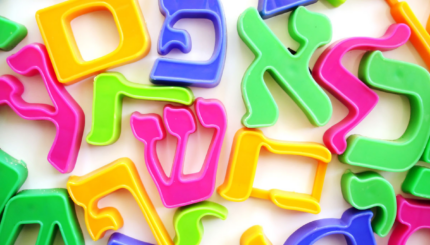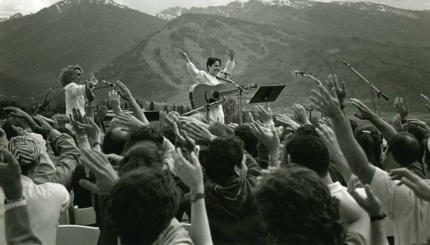Naomi Shemer was born in 1930 on Kevuzat Kinneret, where both her parents had settled after emigrating from Vilna–Meir Sappir in 1922 and Rivka Shostaliski in 1925. They married in 1925.
Naomi’s musical skill was evident during her childhood, when she began to lead community singing on the . After completing school she was sent to study at the academy of music in Jerusalem and upon returning to the kibbutz taught music to the kibbutz children. During this period she wrote several children’s songs, including “The Short Tour,” “The Post Van,” and “Our Little Brother,” all of which appeared for the first time on an album by Yaffa Yarkoni, “Songs from Kinneret” (1958).
Shemer began her army service in the Nahal, eventually joining its cultural department. During her military service she wrote several songs for a revue by the Central Command troupe, “A Raid in the Village” (1956) under the pseudonym S. Carmel.
After her discharge she married the actor Gideon Shemer in 1954 and had a daughter, Halleli (b. 1956). The couple lived first on Kevuzat Kinneret and afterwards in Tel Aviv.

Help us keep Jewish knowledge accessible to millions of people around the world.
Your donation to My Jewish Learning fuels endless journeys of Jewish discovery. With your help, My Jewish Learning can continue to provide nonstop opportunities for learning, connection and growth.
Getting in the Groove
Shemer became well-known when the musical “Five-Five,” actually no more than an arrangement of her army revue “A Raid in the Village,” was staged. The songs “So Much Light and Blue” and “Song of the Grain,” which were recorded by Rika Zarai, and the very successful “Rely on the Rooster,” which was performed in 1959 by Ran and Nama (Ran Eliran and Nehama Hendel), became hits.
Upon the formation of the Green Onion troupe, most of whose members were former members of the Nahal troupe, Chaim Topol, one of its founders, commissioned several songs from Shemer. These included “Noa” and “Troubadour,” performed by Nehama Hendel when she joined the group in 1957, though “Noa” was taken off the program after several performances.
Shemer wrote many songs for musical troupes. “Hoppa Hey,” which was written for the Central Command troupe, won first place in the international song festival in Pisaro, Italy in 1960.
In 1964 Shemer composed a musical setting for the poem “Kinneret” (“There are the Golan Heights”) by Rahel, originally performed by the Central Command troupe. Later she set to music other poems about the Kinneret by Rahel, including “In My Garden” and “Song (To You and About You)”, which were recorded in 1966 by the Shemer Sisters, a group she established in 1966 which disbanded after a year.
After separating from her husband in 1967, Shemer visited Paris with her daughter, sending the songs “For You” and “The City in Gray” to the Yarkon Bridge Trio. Shemer also translated French songs into Hebrew, including “Snow White” (performed by the Twins Trio in 1966), “The Birds” (performed by the Nahal Troupe, original French title: “Si Tous Les Oiseaux”) and many songs by Georges Brassens (1921–1981), which she translated for Yossi Banai’s revue, “There Are No Happy Love Affairs.”
Writing “Jerusalem of Gold”
In 1967 Shemer wrote “Jerusalem of Gold” for the annual song festival. She recalled:
The idea I started with was the Talmudic legend I remembered from my school days about Rabbi Akiva, who lived in poverty, in a hayloft with his beloved wife Rahel, who had been disowned by her father. As he plucked the hay out of her hair, he promised her that one day he would become wealthy and buy her a Jerusalem of Gold [an item of jewelry]. Our teachers, Shoshana and Amminadav, taught us many similar legends. The phrase “Jerusalem of Gold” suddenly shone in my memory as if to say, “Here I am,” and I realized it would be the cornerstone of my song.
It was night by the time I sat down and wrote the song. I began with my fresh, innocent memories of my visits there during summer vacation, and then I continued to “She sits alone” and “captive in her dream,” and to the ancient phraseology which had just presented itself to me as if to say, Take me and do with me as you will.
As for the melody, here I touched upon the hasidic melodies and Yiddish songs of my late father with faint traces of Biblical cantillation. When I got to the refrain, I changed the direction upward, and it was as though I had drawn the curves of the old road near Moza as it approaches Jerusalem, known as the “Seven Sisters”: one ascent, and then another and another, and behold–the city before our eyes.
Over the next few days I played the song for whoever came to visit, as I always do. Once I played it for Rivka Michaeli. She asked: What about the Old City? All right, I said, if you really want it, and I added the middle verse.
The business about the Old City needs an explanation. When I went to write about it, I put all thought of physical, tangible matters out of my mind. I thought about the two thousand years of the Destruction in the abstract, not necessarily about the last nineteen years. Through a kind of telescopic lens I saw before me a city in heaven and the essence which alone I sought to capture.
But Who Will Sing It?
Naomi Shemer deliberated as to who would sing the song. Her daughter Halleli had heard about an unknown woman soldier with an extraordinary voice and Shemer was very impressed after hearing her on the radio. She asked to be introduced to the singer and thus met Shuly Nathan.
Shemer insisted that Nathan sing “Jerusalem of Gold” with guitar rather than with orchestral accompaniment. After the prizes were awarded the audience stood up, demanding to hear the song again. The second time, the entire audience joined in the refrain. Three weeks later the Six Day War broke out, and Jerusalem was reunited.
The paratroopers who liberated the city sang the song on the Temple Mount and by the Western Wall. After the war, Shemer added another verse beginning “We have returned to the wells.” When she sang the new version for the paratroopers and they applauded her, she told them: “Actually I should be applauding you, since it is much easier to change a song than to change a city.”
Since the first time “Jerusalem of Gold” was performed at the Song Festival it has been considered the best-loved Israeli song of all time. (It later won first place in the “Hit of the Hits” parade of 1998, the year of Israel’s fiftieth anniversary, and was chosen as the Jubilee song.) All the Songs of Naomi Shemer was published at the end of 1976.
Other Prominent Songs
The years after the Six Day War were all marked by Shemer’s songs.
When the Yom Kippur War broke out in 1973, it was Shemer’s song “Lu Yehi” (“May It Be”) that best expressed the feelings of both the battlefront and the home front. The words were written at the request of the singer Alberstein to the melody of the Beatles’ song “Let It Be.” However, the Hebrew version is not a translation but a version that reflects the mood and the distress of that difficult time.
In 1979, when her sister Ruti was widowed, Shemer wrote “Of Sting and Honey” for her as a song of encouragement. Yossi Banai sang it on a television program and included it in his one-man show, “Simon, Little Moïse and I.” Thus, with Banai’s help, the private prayer Shemer had written became the prayer of many, and the line “Do not uproot what has been planted” received political significance when it became the motto of those who opposed the evacuation of Yamit.
Shemer was awarded the Israel Prize in 1983.
Final Years
During the 1990s a decline in Shemer’s health affected her writing, but every new song she wrote received a warm welcome.
In 1994 the Hebrew University of Jerusalem awarded Shemer an honorary doctorate and in 2001 she received one from Tel Aviv University. In 2000 she became a member of the Hebrew Language Academy.
Naomi Shemer’s songs are sung by everyone–in kindergartens, schools, youth movements and army units, at events both of rejoicing and of mourning.
Her final piece, Ilan, composed just three weeks before her death, was a tribute to Israeli astronaut Colonel Ilan Ramon (1954–2003), who died in the explosion of the space shuttle Columbia on February 1, 2003.
Naomi Shemer died on June 26, 2004 at Ichilov Hospital in Tel Aviv from consequences of her long bout with cancer. She was buried at her birthplace, Kibbutz Kinneret, overlooking the lake of which she had so often sung. In fulfillment of her request, the mourners at her funeral–broadcast on national television–gave no eulogies; three of her songs were sung instead.
Reprinted from Reprinted from the Shalvi/Hyman Encyclopedia of Jewish Women with permission of the author and the Jewish Women’s Archive.


